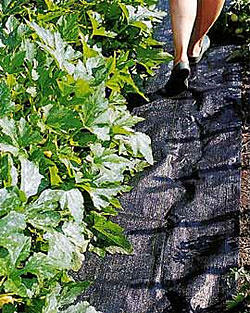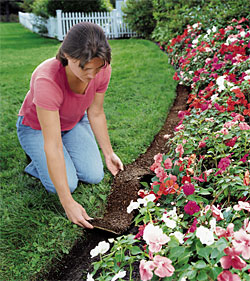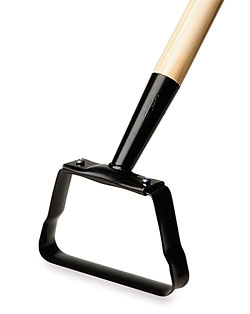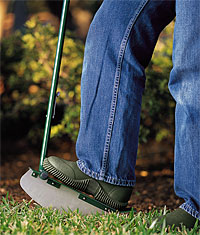





As a founding employee of Gardener's Supply, I wore many different hats over the years. Currently, I have my own company called Johnnie Brook Creative. The gardens around my home in Richmond, VT, include a large vegetable garden, seasonal greenhouse, cutting garden, perennial gardens, rock garden, shade garden, berry plantings, lots of container plants and a meadow garden. There's no place I'd rather be than in the garden.

Pathways: Keep walkways in the vegetable garden weed-free with roll-out Pro Weed Mat.

Bed edges: The garden always looks better with a crisp edge. Use roll-out edging — in recycled rubber or coco fiber — to maintain a nice edge all season.

In the beds: The long-handled Hula Hoe makes it easy to eliminate random weeds that spring up.
Weeding is not all bad. There's actually something wonderfully therapeutic about it. Very little brain energy is required, and I find that with my hands busy, I'm free to daydream, ponder the big questions, or just check out for awhile. For me this is true whether I'm weeding around vegetable plants, weeding the cutting garden, or weeding in the perennial garden.
Pathways in the vegetable and cutting gardens are a real challenge for me. Years ago I used to till the paths every few weeks during the first half of the growing season. But over the years, I've crammed more and more plants into the beds, and the pathways have gotten narrower and narrower. Once the plants begin to fill out there's simply no way to get the 7-hp tiller between the rows. Besides, I have come to believe that less tilling is better. I don't like the noise, and frequent tilling also speeds moisture loss and "burns up" organic matter.
I've tried mulching the paths with straw, but straw mulch is expensive, and the sprouted oat plants that grow up are almost as difficult to deal with as the weeds they suppress.
Another pathway solution that's worked quite well for me is a layer of newspaper covered with recycled coffee bean bags. I get the burlap bags free from a local coffee roaster. The aesthetics leave something to be desired, and I'm a bit concerned about what noxious chemicals those coffee bags might have been sprayed with in order to keep the beans bug- and disease-free, but with a heavy layer of newspaper underneath, the bags usually last the entire season. They're also nice to walk and kneel on.
The pathways in my cutting garden and shade garden are more permanent, and I've had pretty good luck controlling weeds with the Pro Weed Mat, which can be walked upon.
My apple trees, lilac hedge, dwarf conifer garden, and foundation plantings are also covered with Weed Mat and a 2-3″ layer of wood chips. Some areas have been pretty weed-free for five or six years now. The only troublesome weeds (other than dandelions, which I have seen sprout in concrete) are those ground ivies that creep over the top of the mulch from the surrounding lawn. They usually pull off pretty easily because they penetrate the wood chips but not the fabric. I find that wood chips (I get a truckload from a local tree-trimming company) last much longer than the shredded bark mulch. They look a bit coarse, but for the outlying areas, they're fine — and the price is right. An interesting new solution is the recycled rubber Tree Rings. They're air and water-permeable, an inch thick (so they'll stay put without staples or mulch) and they will last for many years.

Cut a crisp bed edge with the Steppin' Edger.
As for dealing with the grass that creeps in from every edge of every garden, I can recommend two solutions. The first is an edging tool. This half-moon shaped tool has been used in British gardens for hundreds of years to cut clean edges around gardens, along pathways, around landscape plantings, and anywhere grass meets garden. Unless you have a very large garden, you can probably edge everything in a couple hours. The trick is to keep after it once a month or so. (That's a useful tip I must admit I don't follow—my beds usually get edged only in the spring.)
For a "put it in once and have it over with" solution, I enthusiastically recommend plastic edging. I've installed hundreds of feet of plastic edging, and it now surrounds my vegetable garden, cutting garden, perennial gardens, and shade garden. I have several areas where the edging has been in for 12 years, and it still works great. Unless you look very closely, you can't see the edging. I install it flush with the soil level, with only the rolled edge sticking up. I don't even own a weed trimmer—the mower blades go right over the edging for a neat, finished look. If your soil is not very stony and you don't get a lot of frost in the ground, you may want to try Pound-In Edging. It comes in several heights and is easy to install.
Alas, even with the best of preventative measures, weeds happen. When I do have to weed, here are a couple of my favorite weeding tools: my right hand, a hand fork and a hoe.
Copyright © www.100flowers.win Botanic Garden All Rights Reserved